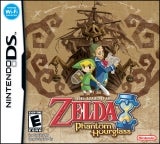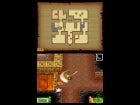Usually when a movie studio doesn't send out screeners to reviewers, there's a little cause for concern. The same goes for video games, too. If previews aren't written, then there's always that worry that the game might be a stinker. Recently, Nintendo had that problem with the Japanese release of The Legend of Zelda: Phantom Hourglass for the Nintendo DS. Up until its release last Saturday, there wasn't a whole lot of coverage going on from the time it was unveiled at E3 last year until now. But with a glowing 39/40 review from Famitsu magazine, it looks like all fears and worries about the game being less than amazing are put to rest. So how is the game after all?
In one word, you could sum it up as "nostalgic." Unlike the mature Twilight Princess, Phantom Hourglass utilizes a style reminiscent of the GameCube's Wind Waker, and it should, seeing as it's a direct sequel to that borderline classic. But the feeling one will get with the Phantom Hourglass is akin to playing A Link to the Past or indeed the original Zelda on NES. There will be a lot of "oh wow, I didn't think about that!" moments in the game that honestly, many fans of the series thought Twilight Princess was missing. A lot of this is due in part to the revamped control system on the DS.
Utilizing every single feature of the DS, Phantom Hourglass totally changes the way you control Link, and in turn makes the exploration, puzzle-solving and combat aspects of the game so fresh and fun that it may be hard for people to go back to a Zelda game with traditional controls. Similar in theory to Blizzard's Diablo series, controlling Link requires use of the stylus. Tap a point on the screen and Link will walk there. Drag it across the screen and he'll start running. If you spot an enemy, simply tap it and Link will go up and slice it up with his sword. The classic spin attack is done by drawing a circle around Link's body. Moving and attacking with Link is easy enough, but that's not where the innovation ends.
Just about every DS feature is used in the game at one point or another. The microphone is used to solve puzzles, and several sub-items that you will find in the game also use the touch screen. For example, you can tap a spot to throw the trademark boomerang, or you can hold down the L or R trigger, and draw the path of the boomerang on the screen before letting it fly. In fact, doing this is the only way to defeat some enemies and solve puzzles. The details of said uses won't be discussed here to avoid spoilers, but gamers are going to have a hell of a time with some of the puzzles and traps that are in the short but entertaining dungeons of Phantom Hourglass.
Staying true to the Wind Waker theme, Link befriends a pirate by the name of Reinbech. The pronunciation of the name sounds like "Lineback" in Japanese but Reinbech sounds a lot cooler. In any event, once Reinbech is located in the game, Link can use his ship to travel various parts of the world that are located on the sea charts scattered throughout the game. The touch screen again comes into play when on board the ship. You can touch the screen to alter the camera view and creating a travel route to your destination has never been easier. Simply draw a line between your ship and your destination and it's done. As you progress further, items can be obtained to improve your boat, too.
The Wind Waker art style is once again utilized here, which perfectly suits the capabilities of the DS. The bright colors and cel-shaded graphics work really well with the system since 3D isn't exactly its forte. Phantom Hourglass gives it a good go though, with cutscenes that are reminiscent of its console brother.





